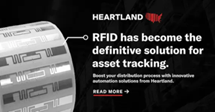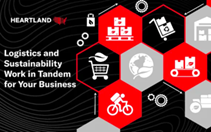
5 Ways to Optimize Your Sustainable Warehouse Strategy
Mar 11, 2024
Warehouse optimization should be a top priority for all businesses, as excessive stocking is directly connected to increased total cost of ownership (TCO) and greater consumption of energy since businesses must track, manage, and protect stock from early spoilage—which may sometimes be unavoidable if stock levels are too high. At Heartland, our automated solutions—such as RFID warehouse management technology, for example—are designed to streamline your warehouse layout for workflow while maximizing both overall efficiency and sustainability. It is crucial for any business to know how to avoid overstocking while remaining agile in response to supply chain challenges and demands by utilizing warehouse technology. There are many applicable benefits of sustainability concerning operational visibility and profitability for the supply chain, such as:
- Demand regulations for traceability – Visibility over the supply chain is a vital factor in guaranteeing seamless operations, but it is still a challenge for many businesses. The lack of instant visibility into supplier performance, levels of inventory, and transportation conditions can generate inefficiencies throughout a warehouse’s distribution process. In fact, in a study conducted by the Food and Drug Administration (FDA), a reported 9 million units were recalled from stores. Consequentially, brand new regulations—such as the RFID label requirement, for example—require smoothly traceable visibility throughout all points of the supply chain. As mandates grow stricter, warehouse must continue to consciously phase out manual reporting methods. This can be done through Heartland’s expert, automated solutions—which can utilize barcode scanning and software for warehouse inventory management that can record product status to make sure quality expectations are met. Essentially, automated warehouse labeling replaces pen-and-paper reporting because employees only need to scan barcodes to authenticate a product’s origin instead of going through handwritten notes.
Related: Big Retailers are Demand RFID Tracking. Here’s why:
- Constraints on transportation and capacity – Declining talent in the logistics industry is a growing challenge that is expected to continue throughout 2024. In fact, a recent study suspects that there will be a 160,000-truck driver shortage by 2030 as businesses continually try to recruit and retain qualified and talented drivers. This shortage of truck drivers, along with external factors like foreign tensions, can generate further delays in shipping, increased costs, and even possible shortages of products. To combat these factors, many companies have shifted toward near-shoring and moving closer to urban areas with the goal of lowering shipping and handling costs. However, automated material movement has also become prominent in manufacturing and distribution facilities. Pieces of automation like robotic forklifts and conveyor belts can assist warehouses in enhancing their operations while reducing their reliance on manual labor. By choosing to automate tedious and physically demanding tasks, warehouses can open their workforce to focus on more complex tasks—such as inventory level management, for example.
Related: How Sustainability and Logistics Thrive Together
- Continuous push for sustainability – Things like severe weather events, rising sea levels, and any other environmental elements can breach supply chain operations and create considerable financial losses. Businesses will have to invest in the implementation of sustainable procedures to decrease their carbon footprint while constructing more resilient supply chains that safeguard both the bottom line and the planet. To do so, one of the first shifts toward sustainability is to appraise the warehouse’s impact on the environment. As a result, they will need to measure the levels of energy consumption, water usage, and generated waste. In addition to that, warehouses are also urged to diminish their reliance on numerous electronic devices. Things like next-generation handheld computers and voice-directed solutions can be utilized to centralize essential tasks like communication among staff, ERP inventory management, and sharing data into one eco-friendly terminal, which lowers future e-waste.
RELATED: HOW TO PRESERVE SUSTAINABILITY IN 5 CRUCIAL WAREHOUSING WORKFLOWS
- Cybersecurity risks – As the digitization of the processes of today’s supply chain continues, cybersecurity risks continue to be a substantial concern. In fact, today’s researchers propose that over 800,000 people experience a cyberattack every year. Cyberattacks can be extremely detrimental to a business as they cause breaches in data, compromised data, and damage to reputation. With the consistently growing presence of interrelatedness among supply chains across the world, it is important to institute powerful cybersecurity procedures to stay safe from any potential threat. As such, open communication is pivotal in establishing a dependable and adaptable cybersecurity process. Along with that, policy guidelines must include instructions for the management of passwords, access control, and security of networks. In addition to that, all workers should be trained on appropriate cybersecurity processes, such identifying phishing emails and evading suspicious downloads. Furthermore, businesses must prioritize the implementation of supported operating systems (OS) like Android for enterprise to influence ongoing security updates and patches.
Related: How to Assess Your Cybersecurity Plan
- Getting started – Ultimately, the journey toward sustainable warehousing starts the same way with everyone: by simply getting started. However, the first step required in establishing a modernization plan may look different depending on the business or industry. With that said, meeting with an experienced and qualified solution provider is a good way to build a solid base for your solution. By working with modernization experts—like Heartland—will enable businesses to:
- Precisely Evaluate Difficult Sectors: Qualified providers come with unmatched expertise in identifying and acknowledging inefficiencies in operations, as well as dead zones and any other challenges that may interfere with device performance and connectivity signals. These evaluations will also enable your provider to suggest alterations that will optimize warehousing operations, diminish bottlenecks, and improve overall efficiency.
-
- Identify Key Performance Indicators (KPIs): Depending on the goal of your specific solution, KPIs will vary when measuring order throughput, rates of returns, and accuracy percentages. For example, companies who want to optimize their putaway and storage processes may want to analyze the time it takes for their employees to pick orders—as this can reflect on if items were properly stored or not.
- Select Premium Warehouse Equipment: The relationship between a solutions provider and a manufacturer provides insight into the latest trends regarding warehouse equipment. When working with a solutions provider, businesses will be able to confirm that they are making the proper investments in hardware selection that will inevitably enhance their operations and establish sustainability procedures within their warehouses.
- Prepare Hardware: Dynamic systems—like barcode technologies, for example—are pairable with tracking software to amplify visibility. At Heartland, we test our solutions to assure that they are adequately functional with the appropriate management tools. Upon device staging, solutions will then be deployed throughout the warehouse, establishing a seamless transition as well as minimal interruption to operations.
- Verify Visibility: When in the piloting stage, IT teams will work with certain employees to assess the efficiency of the solution in your real-life, tangible space. This group will give feedback on the solution’s visibility, level of efficiency, and any possible concerns that may appear.
- Survey Solution Performance: Once deployed, it is important to observe device performance and keep track of any feedback to speed up training and protect ROI. This process can include consistent software updates, troubleshooting, and any other necessary technical support. Creating a plan for asset management assists in impeding breakdown and missed maintenance schedules, ensuring that your automated tools stay up-to-date and your warehouse runs efficiently and sustainably.
At Heartland, we take great pride in offering businesses automated solutions that are scalable and sustainable. In today’s world, businesses shouldn’t have to choose between sustainability and efficiency. With Heartland’s expert solutions, you get both. If you’re looking to maximize your warehouse in the name of efficient sustainability, contact our team today.






